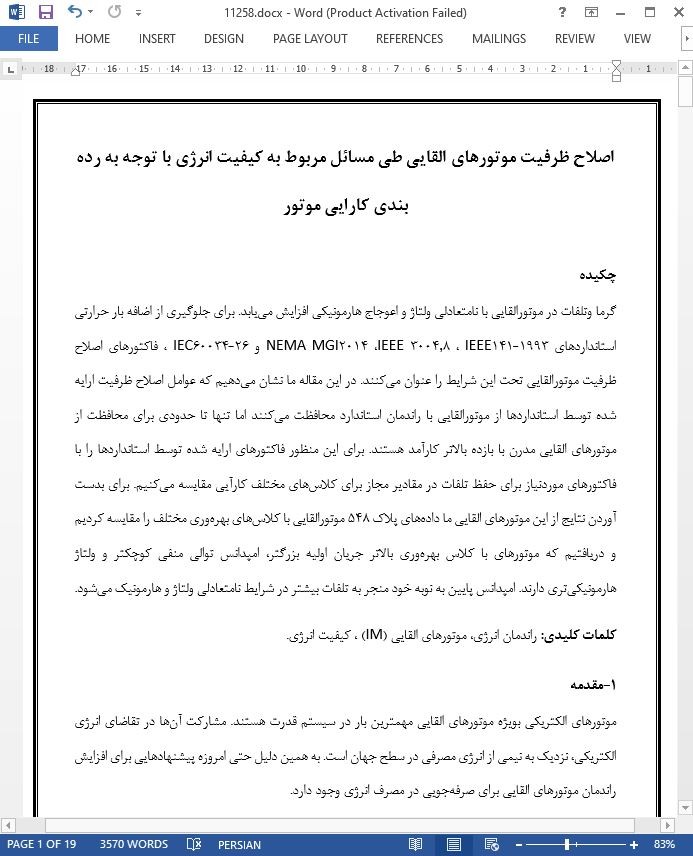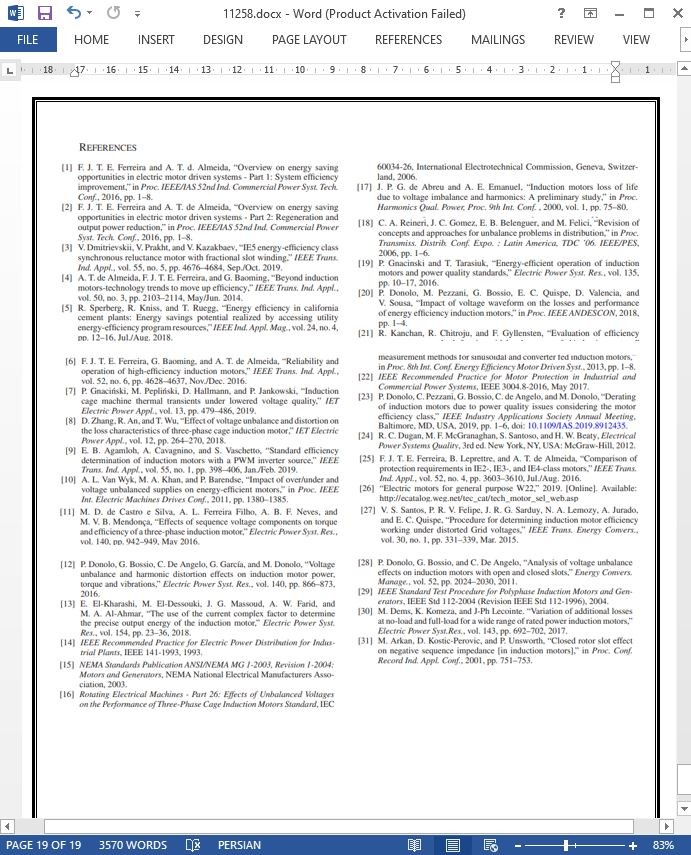
اصلاح ظرفیت موتورهای القایی طی مسائل مربوط به کیفیت انرژی
چکیده
گرما وتلفات در موتورالقایی با نامتعادلی ولتاژ و اعوجاج هارمونیکی افزایش مییابد. برای جلوگیری از اضافه بار حرارتی استانداردهای 1993-141 IEEE، 3004.8 IEEE، 2014NEMA MGI و 26-60034IEC ، فاکتورهای اصلاح ظرفیت موتورالقایی تحت این شرایط را عنوان میکنند. در این مقاله ما نشان میدهیم که عوامل اصلاح ظرفیت ارایه شده توسط استانداردها از موتورالقایی با راندمان استاندارد محافظت میکنند اما تنها تا حدودی برای محافظت از موتورهای القایی مدرن با بازده بالاتر کارآمد هستند. برای این منظور فاکتورهای ارایه شده توسط استانداردها را با فاکتورهای موردنیاز برای حفظ تلفات در مقادیر مجاز برای کلاسهای مختلف کارآیی مقایسه میکنیم. برای بدست آوردن نتایج از این موتورهای القایی ما دادههای پلاک 548 موتورالقایی با کلاسهای بهرهوری مختلف را مقایسه کردیم و دریافتیم که موتورهای با کلاس بهرهوری بالاتر جریان اولیه بزرگتر، امپدانس توالی منفی کوچکتر و ولتاژ هارمونیکیتری دارند. امپدانس پایین به نوبه خود منجر به تلفات بیشتر در شرایط نامتعادلی ولتاژ و هارمونیک میشود.
1-مقدمه
موتورهای الکتریکی بویژه موتورهای القایی مهمترین بار در سیستم قدرت هستند. مشارکت آنها در تقاضای انرژی الکتریکی، نزدیک به نیمی از انرژی مصرفی در سطح جهان است. به همین دلیل حتی امروزه پیشنهادهایی برای افزایش راندمان موتورهای القایی برای صرفهجویی در مصرف انرژی وجود دارد.
برای توسعه موتورهای القایی کارآمدتر استاندارد30-60034IEC از سال 2008 سه کلاس کارآیی را مشخص کرد. رعایت این کلاسها حداقل سطح کارآیی را برای هر نوع موتورالقایی تضمین میکند. این کلاسها عبارتند از:راندمان استاندارد IE1، راندمان بالا IE2، راندمان برتر IE3. در تجدیدنظر بعدی درمورد این استاندارد دو کلاس کارآیی جدید، راندمان کلان IE4 و راندمان افراطی IE5 اضافه شد.
6-نتیجه
در این مقاله ، اثر عدم تعادل ولتاژ و اعوجاج هارمونیک بر تلفات موتورالقایی در کلاسهای مختلف راندمان را بررسی کردیم.
ما ابتدا دادههای پلاک 548 موتورالقایی را مورد مطالعه قرار دادیم تا نشان دهیم که موتورهای باکلاس راندمان بالاتر با جریانهای شروع بالاتر(pu) ارتباط دارند. سپس ، ما به کار ارائه شده در مقالههای گذشته توجه کردیم ، که در شرایط نامتعادلی و اعوجاجات ولتاژ جریان شروع بالاتر با امپدانسهای توالی منفی پایینتر و تلفات بالاتر همراه است.
Abstract
Heating and losses of induction motor (IM) grow with the supply voltage unbalance and harmonic distortion. To avoid thermal overload, the IEEE 141-1993, the IEEE 3004.8, NEMA MG1-2014, and the IEC 60034-26 standards establish derating factors for IMs operating under those conditions. In this article, we show that while the derating factors proposed by these standards adequately protect standard-efficiency IMs, they are only marginally adequate to protect modern higher-efficiency IMs. To this end, we compare the derating factors provided by the standards with the derating factors required to maintain the losses at rated values in a standard-efficiency IM, in a premium-efficiency IM, and in a super-premium-efficiency IM. To extrapolate the results from these IM, we compared the nameplate data of 548 IMs of different efficiency classes and found that higher efficiency classes correlate to higher IM starting currents and lower impedances to the negative sequence and harmonic voltages. These lower impedances in turn may lead to higher losses for unbalanced and harmonic voltages conditions.
I. INTRODUCTION
ELECTRIC motors, and in particular induction motors (IMs), represent the most important load in the electric power system. Its participation in the demand for electric energy is close to half of the energy consumed globally [1], [2]. For this reason, even today, there are proposals to increase the electric motors efficiency to yield large energy savings [3].
To promote the development of more efficient IMs, the IEC 60034-30 standard from 2008 specified three efficiency classes. Compliance with these classes guarantees a minimum efficiency level for every type of IM and nominal power. These classes are: standard efficiency or IE1, high efficiency or IE2, and premium efficiency or IE3. A later revision of this standard includes two new efficiency classes, the super-premium or IE4 and ultra-premium or IE5 [4].
VI. CONCLUSION
In this article, we study the effect of voltage unbalance and harmonic distortion on the losses of IMs in different efficiency classes.
We first studied the nameplate data of 548 IMs to show that higher efficiency class IMs are correlated to higher starting currents in p.u. Then, we drew attention to the work presented in [24], where higher starting current are associated with lower negative-sequence impedances and to higher losses for unbalanced and distorted voltage conditions.
چکیده
1-مقدمه
2-جریان اولیه برای کلاسهای بهرهوری مختلف موتورالقایی
2-1-تعاریف
2-2-تحلیل جریانهای آغازین
3-مدل و پارامترهای موتورالقایی برای نامتعادلی ولتاژ و اعوجاج هارمونیکی
3-1-مدل موتورالقایی برای نامتعادلی ولتاژ واعوجاج هارمونیکی
3-2-پارامترهای موتور تحت آزمایش
4-اعتبار و پارامترهای مدل تحت شرایط نامتعادلی ولتاژ
4-1-تست نیمکت
4-2-اعتبار و پارامترهای مدل تحت شرایط نامتعادلی ولتاژ
5-مقایسه فاکتورهای اصلاح ظرفیت
5-1-فاکتور اصلاح ظرفیت برای شرایط نامتعادلی ولتاژ
5-2-فاکتورهای اصلاح ظرفیت برای شرایط اعوجاج هامونیکی
6-نتیجه
Abstract
I. INTRODUCTION
II. STARTING CURRENTS FOR DIFFERENT EFFICIENCY CLASS IMS
A. Definitions
B. Analysis of Starting Currents
III. IM MODEL AND PARAMETERS FOR VOLTAGE UNBALANCE AND HARMONIC DISTORTION
A. IM Model for Voltage Unbalance and Harmonic Distortion
B. Parameters of the IMs Under Test
IV. VALIDATION OF THE MODEL AND PARAMETERS UNDER UNBALANCED VOLTAGE CONDITIONS
A. Test Bench
B. Validation of the Model and Parameters Under Unbalanced Voltage Conditions
V. COMPARISON OF DERATING FACTORS
A. Derating Factors for Unbalanced Voltage Conditions
B. Derating Factors for Harmonic Distortion Conditions
VI. CONCLUSION
- ترجمه فارسی مقاله با فرمت ورد (word) با قابلیت ویرایش، بدون آرم سایت ای ترجمه
- ترجمه فارسی مقاله با فرمت pdf، بدون آرم سایت ای ترجمه



